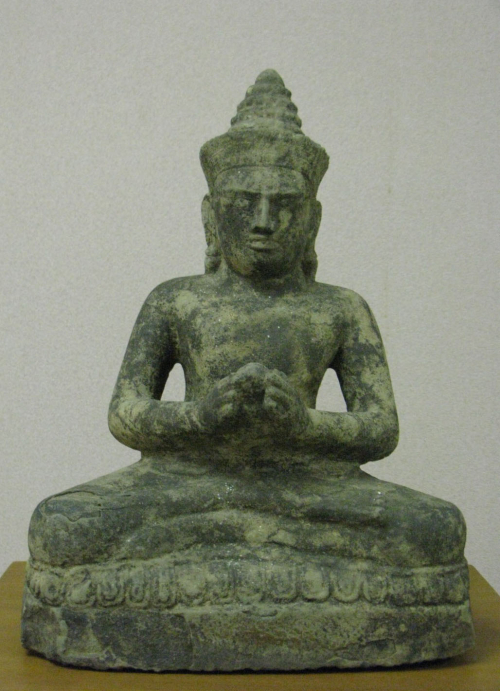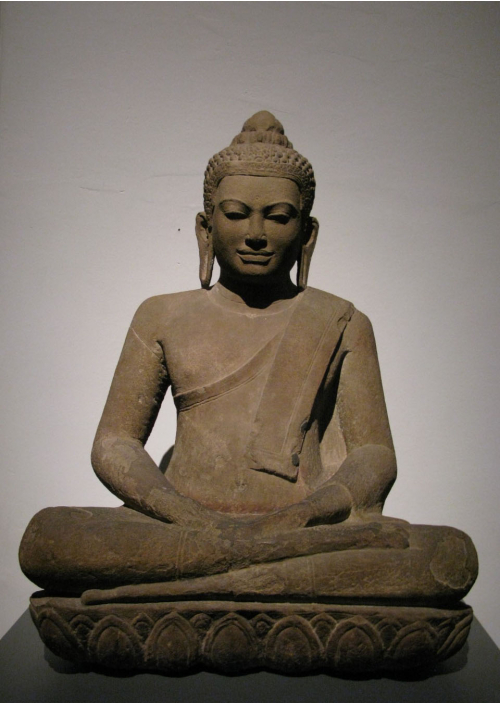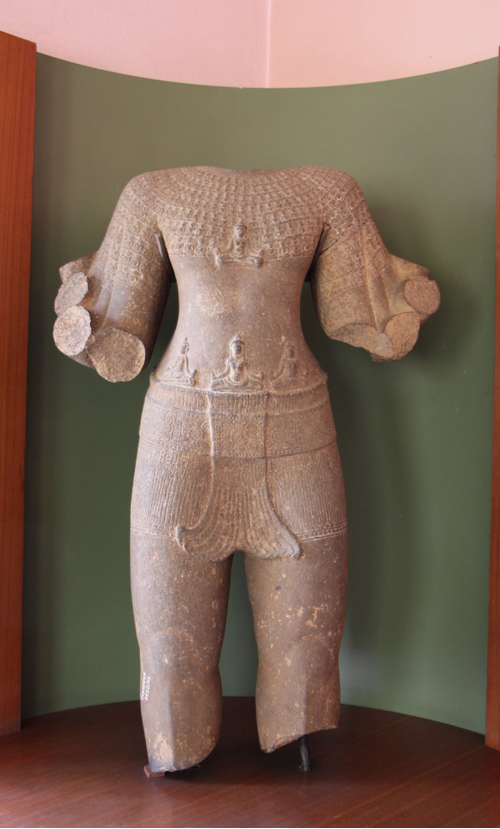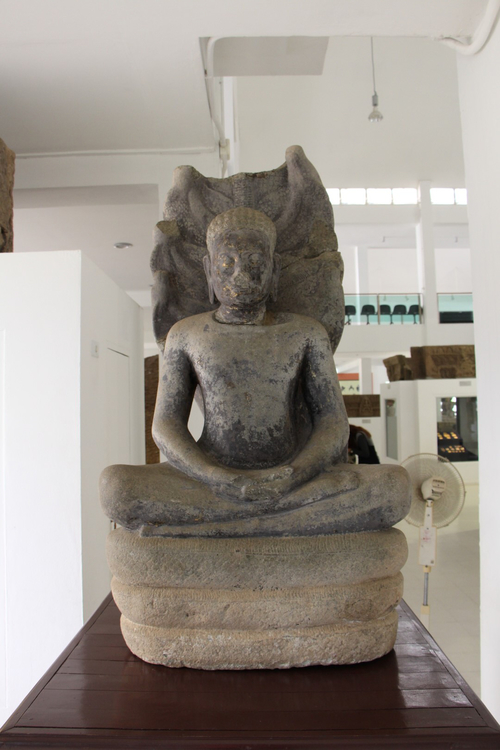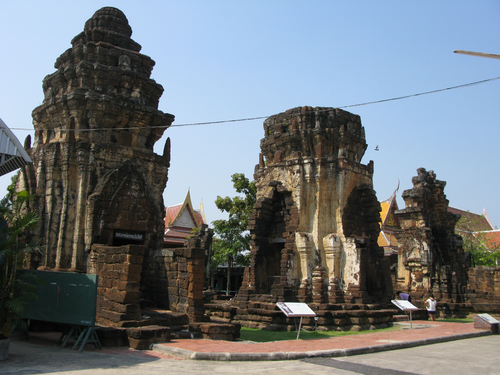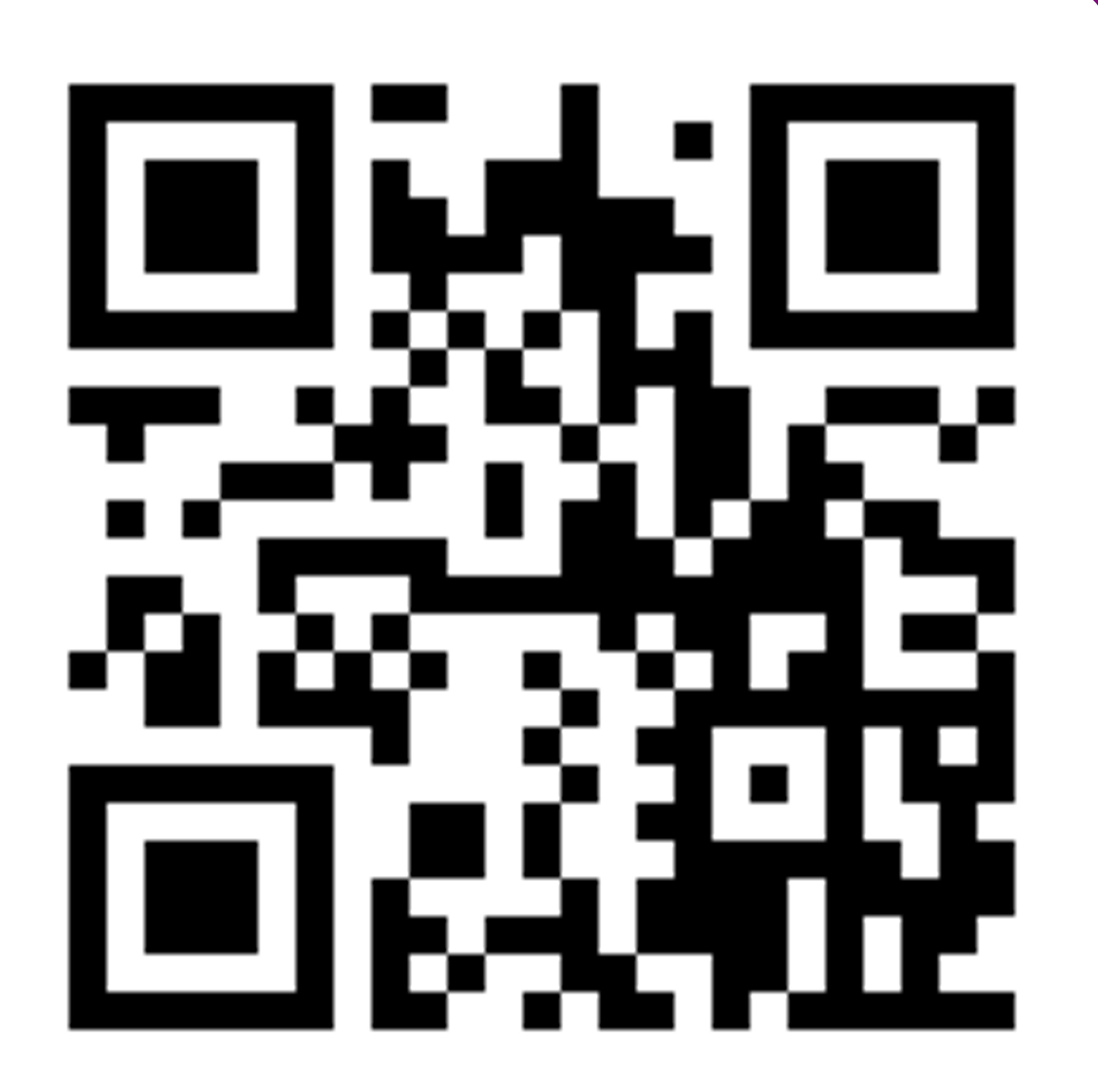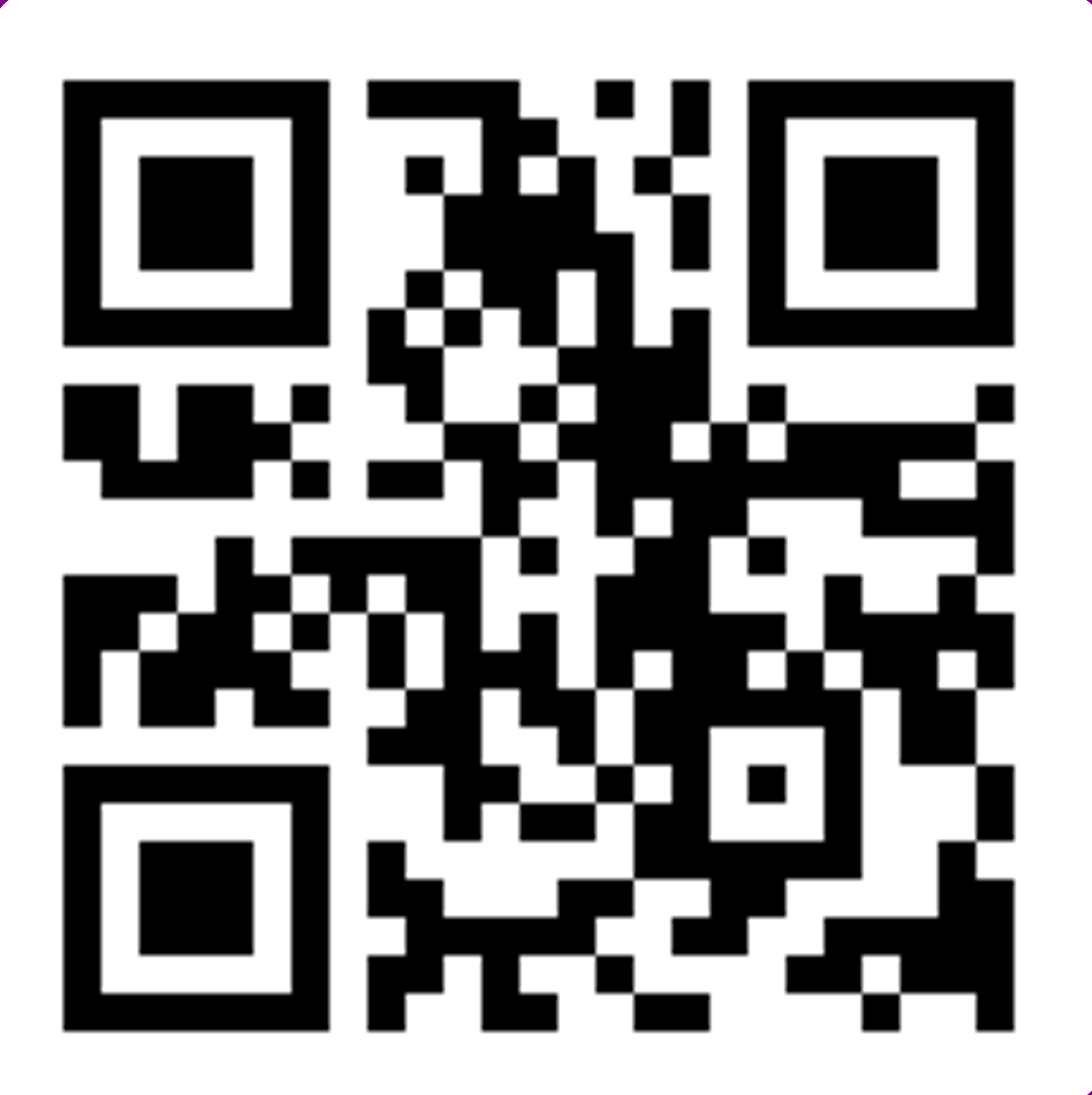ค้นหางานศิลปกรรม
ฐานข้อมูลศิลปกรรมในเอเชียตะวันออกเฉียงใต้
ประติมากรรมพระพุทธรูปนาคปรก
พระพุทธรูปอยู่ในอิริยาบถนั่งขัดสมาธิราบ พระหัตถ์ทำปางสมาธิ ประทับอยู่บนขนดนาค เบื้องหลังมีพังพานนาคปรกไว้พระพักตร์เหลี่ยม สวมเครื่องทรงมากชิ้น ได้แก่ กุณฑลทรงตุ้มแหลม กระบังหน้าและรัดเกล้ากรวยอันประกอบด้วยชั้นลดหลั่นของแถวกลีบบัว เป็นหนึ่งในลักษณะเด่นของพระพุทธรูปศิลปะเขมรแบบบายน สวมกรองศอ พาหุรัด ทองพระกร แม้ว่าพื้นที่ระหว่างพระกรกับพระวรกายจะเจาะทะลุทำให้เกิดความรู้สึกว่าเปล่าเปลือย อันเป็นลักษณะเด่นของพระพุทธรูปศิลปะลพบุรี ทว่ากลับปรากฏขอบจีวรเฉวียงพระอุระและชายจีวรสี่เหลี่ยมพาดอยู่บนพระอังสาซ้าย ภายในพระหัตถ์ขวามีตลับกลมวางอยู่ ขนดนาครองรับพระพุทธองค์มี 3 ชั้น ชั้นบนมีขนาดใหญ่ที่สุด จากนั้นจึงลดหลั่นขนาดลงตามลำดับ ตกแต่งลวดลายคล้ายเกร็ดงู นาคมี 7 เศียร รูปทรงดังสามเหลี่ยมหรือใบโพธิ์ เศียรกลางใหญ่ที่สุด เศียรด้านข่างทั้งหกมีขนาดเท่ากันโดยหันขึ้นหาเศียรกลาง
ประติมากรรมพระไภษัชยคุรุ
ประติมากรรมอยู่ในอิริยาบถนั่งขัดสมาธิราบบนฐานหน้ากระดานที่ประดับลายกลีบบัว พระพักตร์ สวมมงกุฎอันประกอบด้วยกระบังหน้าและรัดเกล้ากรวยซ้อนชั้น สวมกุณฑลทรงตุ้มแหลม พระกรกายช่วงบนเปล่าเปลือย พระหัตถ์ทั้งสองประคองหม้อน้ำไว้ในตำแหน่งพระอุทร
ประติมากรรมพระไภษัชยคุรุ
ประติมากรรมอยู่ในอิริยาบถนั่งขัดสมาธิราบบนฐานหน้ากระดานที่ประดับลายกลีบบัว พระพักตร์สี่เหลี่ยม สวมมงกุฎอันประกอบด้วยกระบังหน้าและรัดเกล้ากรวยซ้อนชั้น สวมกุณฑลทรงตุ้มแหลม พระกรกายช่วงบนเปล่าเปลือย พระหัตถ์แต่ละข้างถือวัชระโดยวางซ้อนกันบริเวณพระอุทร
ประติมากรรมพระพุทธรูปปางสมาธิ
พระพุทธรูปอยู่ในอิริยาบถนั่งขัดสมาธิราบบนฐานบัว พระหัตถ์ทำปางสมาธิ พระพักตร์แลดูสี่เหลี่ยม สีพระพักตร์สงบ พระเนตรเหลือบต่ำ พระขนงโก่งกว่าพระพุทธรูปศิลปะลพบุรีทั่วไป พระนาสิกและพระโอษฐ์สมส่วน มีพระอุณาโลมกลมอยู่กึ่งกลางพระนลาฏ ปรากฏแถบไรพระศกที่พัฒนามาจากกระบังหน้าคาดอยู่เหนือพระนลาฏ เป็นหนึ่งในจุดสังเกตที่สะท้อนถึงความแตกต่างไปจากศิลปะลพบุรีทั่วไป พระเกศาเวียนเป็นวงก้นหอย พระอุษณีษะเป็นทรงกรวยแหลม ครองจีวรห่มเฉียง สังฆาฏิสลักนูนเด่นอยู่ในทรงสี่เหลี่ยมขนาดใหญ่พาดอยู่บนพระอังสาซ้าย ฐานบัวที่รองรับพระพุทธองค์ปรากฏแต่เพียงลายกลีบบัวหงาย
ประติมากรรมพระโพธิสัตว์อวโลกิเตศวรเปล่งรัศมี
พระโพธิสัตว์อวโลกิเตศวรเปล่งรัศมีอยู่ในอิริยาบถยืนตรง พระเศียร พระกร และระชงฆ์ตลอดจนพระบาทชำรุดหักหายไปหมดแล้ว บริเวณพระอุระตลอดจนพระอังสา (ไหล่) และพระพาหา (ต้นแขน) ประดับด้วยแถวพระพุทธรูปจำนวนมากมายราวกับเป็นเกราะ กึ่งกลางพระอุระและบั้นพระองค์ปรากฏรูปบุคคลขนาดใหญ่อาจหมายถึงนางปรัชญาปารมิตา สวมสมพตสั้นที่สลักลวดลายอย่างคร่าวๆ ช่วงล่างของพระองค์ตั้งแต่พระอูรุ (ต้นขา) ใหญ่ผิดสัดส่วนตามแบบประติมากรรมในศิลปะบายน
ประติมากรรมพระโพธิสัตว์อวโลกิเตศวรเปล่งรัศมี
พระโพธิสัตว์อวโลกิเตศวรเปล่งรัศมีอยู่ในอิริยาบถยืนตรงบนฐานหน้ากระดานสี่เหลี่ยม สภาพสมบูรณ์มากมีเพียงพระกรทั้งแปดที่หักหายไป พระพักตร์เหลี่ยม พระเนตรปิด แย้มพระโอษฐ์เล็กน้อยตามอย่างศิลปะเขมรแบบบายน ทำให้เกิดความรู้สึกสงบ เกล้าพระเกศาเป็นมวยทรงกระบอก มีรูปพระพุทธเจ้าอมิตาภะประดับมวยผม และมีพระพุทธรูปจำนวนมากประดับพระเศียรแทนเส้นพระเกศา พระองค์ส่วนบนประดับด้วยแถวพระพุทธรูปจำนวนมากมายราวกับเป็นเกราะ กึ่งกลางพระอุระและบั้นพระองค์ปรากฏรูปบุคคลขนาดใหญ่ อาจหมายถึงนางปรัชญาปารมิตา พระกรทั้งแปดหักหายไปแล้ว สวมสมพตสั้นที่สลักลวดลายอย่างคร่าวๆ ช่วงล่างของพระองค์ตั้งแต่พระอูรุ (ต้นขา) จนถึงพระบาทใหญ่ผิดสัดส่วน สวมธำมรงค์ที่นิ้วพระบาททั้งสิบ
ประติมากรรมพระพุทธรูปนาคปรก
พระพุทธรูปอยู่ในอิริยาบถนั่งทำปางสมาธิ ขัดสมาธิราบ พระชงฆ์คมเป็นสันดังมนุษย์จริง ครองจีวรห่มเฉียง บางแนบพระวรกาย ไม่มีริ้ว พระพักตร์สงบ พระเนตรปิด แย้มพระโอษฐ์เล็กน้อย ขมวดพระเกศาเวียนเป็นวงก้นหอย พระอุษณีษะนูนเพียงเล็กน้อย ขนดนาคที่รองรับพระพุทธเจ้ามี 3 ขนด มีพังพานนาคหลายเศียรปกอยู่ทางด้านหลัง
สถาปัตยกรรมปราสาทกำแพงแลง
ปราสาทกำแพงแลงมีผังพื้นล้อมรอบด้วยกำแพงศิลาแลงเป็นรูปสี่เหลี่ยมจัตุรัส หันหน้าไปทางทิศตะวันออก ภายในกำแพงศิลาแลงเป็นที่ตั้งของปราสาทศิลาแลงแบบศิลปะเขมรทั้งหมด 4 องค์ ปราสาท 3 องค์ทางด้านหน้าวางตัวเรียงกันในแนวเหนือ-ใต้ โดยปราสาทประธานมีขนาดสูงใหญ่กว่าอีก 2 องค์ คล้ายกับปรางค์สามยอด ลพบุรี ส่วนปราสาทองค์ที่ 4 ตั้งอยู่ด้านหลังของปราสาทประธานด้านทิศตะวันออก และยังปรากฏลวดลายปูนปั้นประดับปราสาท ด้านหน้ามีโคปุระหรือซุ้มประตูทางเข้า 1 หลัง ภายในกำแพงศิลาแลงยังพบสระน้ำอยู่ชิดขอบกำแพงทางทิศตะวันออกด้วยนอกจากนี้ยังพบโบราณวัตถุสำคัญ ได้แก่ พระโพธิสัตว์โลเกศวรเปล่งรัศมี, ส่วนพระวรกายของพระโพธิสัตว์โลเกศวรสี่กร, ส่วนพระวรกายของพระพุทธรูปนาคปรกทรงเครื่อง, เศียรนางปรัชญาปารมิตา จากการใช้ศิลาแลงเป็นวัสดุหลักในการสร้างปราสาท และลักษณะของการวางผังปราสาททิศเหนือ ปราสาทองค์กลาง และปราสาททิศใต้ เป็นไปในลักษณะการวางตามคติการนับถือรัตนตรัยมหายาน ปราสาททิศเหนือได้แก่พระนางปรัชญาปารมิตา ปราสาทองค์กลาง คือพระวัชรสัตว์นาคปรก และจากปราสาททิศใต้ได้แก่ พระโพธิสัตว์อวโลกิเตศวร ซึ่งคติการนับถือรูปเคารพทั้งสามรูปเรียงกันในแนวนี้ เป็นคติการนับถือรูปเคารพในพุทธศาสนามหายาน สมัยพระเจ้าชัยวรมันที่ 7 พุทธศตวรรษที่ 18 จึงสามารถกำหนดอายุเวลาในการสร้างปราสาทกำแพงแลงนี้ได้ว่าร่วมสมัยกับพระเจ้าชัยวรมันที่ 7 และจารึกที่ปราสาทพระขรรค์ ประเทศกัมพูชา กล่าวถึงเมือง “ศรีชัยวัชรปุระ” (เมืองเพชรบุรี) หนึ่งในหกเมืองโบราณในภาคกลางที่มีการกล่าวต่อไปอีกว่าได้มีการส่งพระชัยพุทธมหานาถ 1 ใน 23 องค์จากเมืองพระนครหลวง มาประดิษฐานที่เมืองเพชรบุรีนั่นก็คือปราสาทวัดกำแพงแลง และเมื่อเทียบกับโบราณสถานแล้ว ก็เป็นสิ่งที่ยืนยันได้ว่า ปราสาทกำแพงแลงแห่งนี้ ก็คือปราสาทที่กล่าวถึงในจารึกนั้น ซึ่งปราสาทพระขรรค์เป็นปราสาทที่ร่วมสมัยกับพระเจ้าชัยวรมันที่ 7 เช่นกัน

